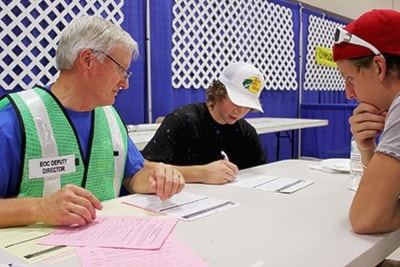Any number of events might call for an area to be evacuated – a pipeline rupture, a dangerous goods spill, a flood, a fire – but 100 Mile House Emergency Support Services (ESS) chose an earthquake.
Director Doug Belcher says his team has the training, and it's time to put it into action.
“The training isn't any good unless you can use it firsthand. That's what we're doing this drill for.”
Players and coaches from the 100 Mile House Wranglers hockey team served as evacuees in ESS's mock disaster drill at the 100 Mile House Curling Club on Sept. 9.
The drill had a lot to do with organization, information management and logistical support, Belcher explains. ESS helps people find accommodations in the first 72 hours following a disaster. They're the people you don't ever want to see, but when disaster strikes, they're the people you turn to for help.
“Frontline workers find out where they fit in and what we can tweak,” Belcher says of the drill.
“We're giving them [evacuees] information, not having them go to the hotel or the restaurant, but we're giving them the information and they can see how it actually works.”
Recent events, such as the flooding in Alberta or the train derailment in Lac-Mégantic, underscore the diversity and volatility of disasters and the need to be well prepared.
“It could be anything. There's so much stuff going by [on the highway] people don't know about. We have the railroad here. We have three pipelines here.”
100 Mile House ESS is part of Emergency Management BC (EMBC) and includes people from all over the 100 Mile House area. They cover from 70 Mile to 140 Mile.
Belcher says he believes 100 Mile House has the facilities to respond should disaster strike.
“We've gone around and signed on hotels we can call. We get quite a few calls in the winter time when there's a single house burnt out. We look after those people for three days, too. Sometimes it takes a couple of days to get (insurance). We've done five this last winter.”
Devastating events, such fires or accidents, often draw a crowd, but sometimes the best option during a disaster – such as a dangerous goods spill on the highway – is to stay where you are, Belcher says. He points to the “shelter-in-place” guidelines from EMBC that state go indoors immediately, close all windows and doors, turn off the furnace, air conditioners and exhaust systems, and listen to your radio or TV for more information.
“They're really pushing that now because there a lot of gas leaks and stuff like that and the idea is to stay in your house and seal it up and make sure everything's fine and we know where you are.”
In 2010, a handful of ESS members responded to a huge forest fire west of Williams Lake.
“It was a real learning experience for all of us and for the whole province because there was language and health [factors to consider] and accommodations were nil because they had so many police and firemen in town.”
Belcher also talks about the forest fire that swept through Barriere in 2003. It destroyed homes and industry and forced thousands of people to leave the area.
“We went eight days here. It was quite an experience to work that. We put in long hours. People came up here and said, 'Well, we have nothing now. The bank can take it back, there's nothing there’.
“It really puts into perspective what's important.”
